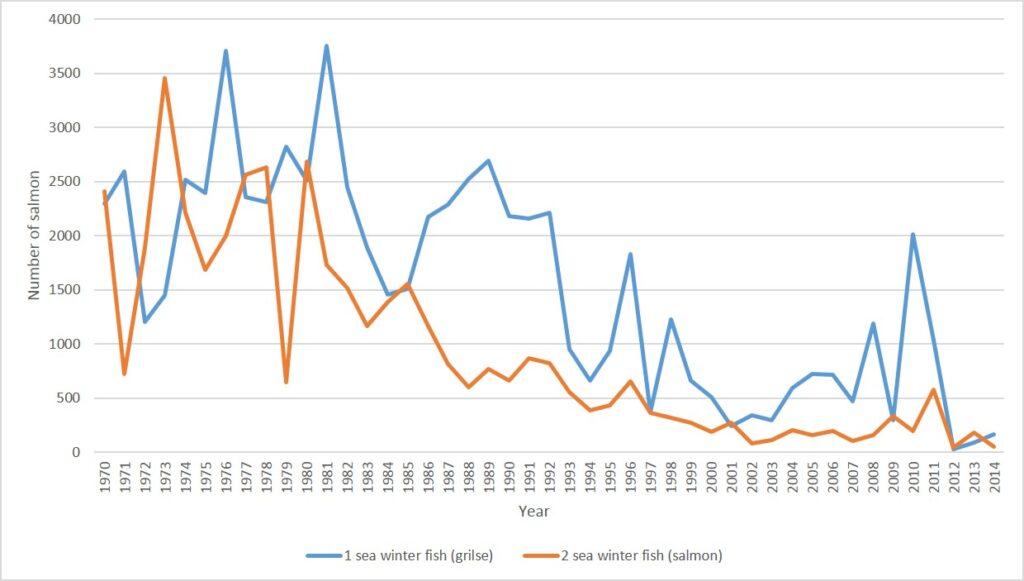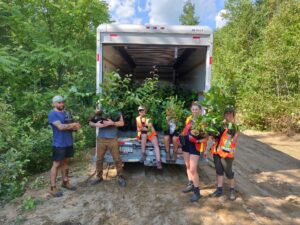The 2014 numbers of salmon returning to the Nashwaak from the ocean are in. One hundred and sixty-three grilse (salmon that winter over in the ocean for only one year) and 48 salmon (defined as having been overwintering in the ocean for multiple years). Last year didn’t look much better than the previous (2013) which saw the continued historic low of returns to the Nashwaak, and many other salmon rivers like the Miramichi.
Those of us who live along and play in the Nashwaak know this trend all too well. The Nashwaak River was once known for its abundance of salmon but over the years there has been a drastic population decrease in the river. In 1970, when the federal Department of Fisheries and Oceans began tracking salmon returns, the adult salmon returning to the Nashwaak River were around 2000 and after a steady decline from the mid 1980’s the number of adult salmon bottomed out at 44 in 2012.
Our summer student, Aliza, asked Peter Salonius a few questions about what is going on. Peter is a past-president of NWAI and has been volunteering since our founding and has following the salmon decline for a long time.
Aliza: What do you think is causing the decline in salmon returning to the Nashwaak?
Peter: While production of juveniles in fresh water has been quite acceptable, the marine survival has been dismal.
Aliza: Hatcheries and rearing programs have been used as a solution for reversing the decline in salmon population, even in the Nashwaak, they have not really helped the salmon populations. Why is that so?
Peter: Hatcheries and rearing programs enhance numbers of salmon juveniles in freshwater (the river), however, when the fish migrate to the ocean to feed, they aren’t surviving and returning back to the river to spawn. Again, it is the marine environment that seems to be causing the problem.
Aliza: Can you elaborate on what you think is the problem is in the marine environment?
Peter: There are a number of factors that may be causing mortality in the ocean as the juveniles migrate to the North Atlantic feeding grounds, including a number of consequences of the intense salmon farming in the Bay of Fundy. Most concerning are the virus diseases present in salt water and the parasitic sea lice that harm farm productivity and infect wild salmon juveniles as they are passing through the area on their way out from the St. John River.
Sea lice usually attach themselves on the skin of salmon and feed off the mucus, blood and skin of salmon. Juvenile salmon are smaller and have not fully developed scales yet so when the sea lice attach themselves to their bodies, they are unable to cope and die.
Aliza: How can we solve the problem that you feel fish farm is contributing?
Peter: We should encourage and possibly subsidize the movement of the aquaculture industry to land and to locations where they will be raised in fresh water, away from net damaging storms, large net damaging animals such as seals, lethal cold water incidents, and the viruses and lice infestations.
Aliza: Do you feel that there is hope for the revival of the Nashwaak salmon population? Do you have thoughts on how we can improve this situation?
Peter: Salmon in the Nashwaak River actually began to recover when the aquaculture industry was able to control sea lice in the 2000s. As you can see on the graph, and the returning spawning salmon increased to over a 1000 annually from mid-2000’s to 2008. But, salmon declined again when the aquaculture industry began to lose control of sea lice starting in 2009. We can improve the situation again by learning from that lesson and moving salmon aquaculture out of salt water.
Aliza: Why do you think drawing attention to the salmon decline is so important?
Peter: Drawing attention to salmon is important as the salmon is a keystone species in the ecosystem. They influence the survival and reproduction of many other species. Salmon are the best coastal ecosystem health indicator as they are extremely sensitive to the changes in the water quality; food sources, and changes in the river flow, turbidity, and temperature. The health of salmon populations is a good indicator of how well we are taking care of the marine and terrestrial ecosystems. Salmon are also very important to the residents of the Nashwaak watershed and people care about what is happening and want to protect and restore the population here.
Early counts on the Miramichi River this year look positive and numbers are rebounding from last year’s low. We’ll be keeping an eye out on the Nashwaak in hopes that’s the case here too.
Stay tuned for another interview about the importance of Nashwaak River salmon, with resident and fly-fishrman Gary Spencer


